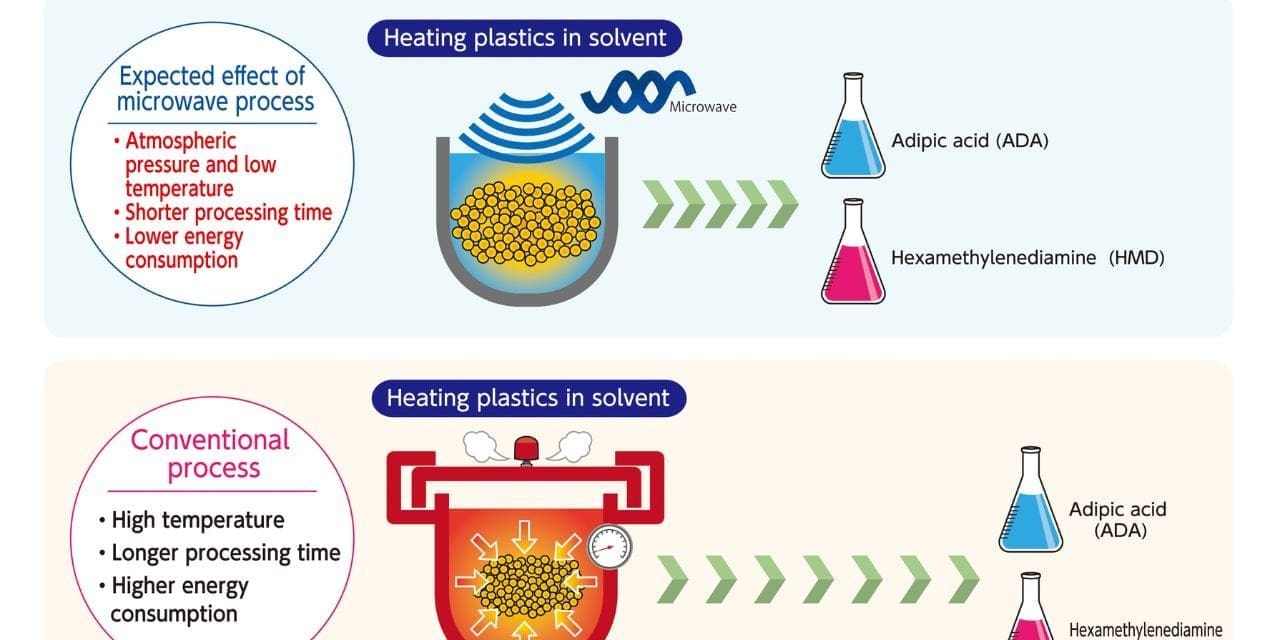In order to commercialise a chemical recycling method for polyamide 661 (PA66, also known as nylon 66), Asahi Kasei and Microwave Chemical initiated a collaborative demonstration project in April 2023. The method is predicted to provide high yield with little energy usage by employing microwaves to depolymerize2 PA66 and extract the monomers hexamethylenediamine (HMD) and adipic acid (ADA) directly. The resultant monomers can then be utilised to create fresh PA66. Depolymerized PA66 manufacturing waste and post-use trash for airbags and automotive components are used in the presentation.
Currently, Asahi Kasei generates HMD and ADA generated from fossil fuels as intermediates to create LeonaTM PA663, an engineering plastic with exceptional heat resistance and rigidity. Several applications call for the use of PA66, including the need for plastic is anticipated to rise globally for airbag fabric, automotive and electronic parts, and yarn.
In order to reduce greenhouse gas (GHG) emissions from chemical goods made from fossil fuels, industrial processes are receiving more attention as the world moves towards carbon neutrality. Using microwaves, which can directly and selectively heat target compounds with great energy efficiency, Microwave Chemical is pushing technological and commercial development to attain carbon neutrality in the industrial sector. Microwave Chemical is developing its unique PlaWaveTM technology platform for microwave-assisted plastic degradation as part of chemical recycling.
Through research and development, combining Asahi Kasei’s more than 50 years of experience manufacturing HMD and ADA with Microwave Chemical’s accomplishments in the industrialization of microwave, With the use of technology, the two businesses hope to market a method of producing PA66 that emits fewer greenhouse gases than the standard method.The high-yield depolymerization of PA66 utilising microwaves, as well as the basic idea of the separation and purification procedure after depolymerization, have been shown in laboratory tests that started in fiscal 2021. By the end of the fiscal year 2023, bench-scale equipment will now be put together at Microwave Chemical’s Osaka factory. The equipment will then be used in a small-scale demonstration trial in the following fiscal year 2024 to gather preliminary process information for commercialization.
The PlaWaveTM technology platform from Microwave Chemical can depolymerize PA66 with minimum energy and produce high yields of HMD and ADA monomers. HMD and ADA data from the PA66 manufacturing process collected byWhen compared to the standard PA66 manufacturing process, this technology’s depolymerization is anticipated to emit fewer greenhouse gases; however, using renewable energy to power the microwaves could further reduce GHG emissions.
This demonstration project seeks to enable resource rotation of PA66 for further GHG emission reduction by confirming the process from depolymerization to separation and purification in an integrated manner.
Following thorough investigation, a choice regarding the likelihood of commercialization will be taken by fiscal 2025 depending on the outcomes of the small-scale demonstration trial. Construction of a business model that incorporates the full value chain in the chemical recycling of PA66 will proceed concurrently with the small-scale demonstration trial, with the goal ofbuild a circular economy alongside PA66 value chain participants.
Through studies of the practical application of material recycling and chemical recycling as well as trials for the commercialization of PA66 made using intermediates derived from biomass, Asahi Kasei seeks to be a global partner for its PA66 customers by offering the best solutions for their carbon neutrality initiatives4.
In order to achieve the practical application of the chemical recycling of polymethyl methacrylate (PMMA, also known as acrylic resin), automotive shredder residue (ASR), plastic containers and packaging, flexible polyurethane foam, etc., Microwave Chemical is working to increase the scale of equipment and to make PlaWaveTM more generally applicable.
1.The two most common varieties of polyamide have differing chemical structures and are known as polyamide 66 and polyamide 6. with excellenceIn industrial settings like automotive and electronics, polyamide 66 is frequently utilised due to its strength and resilience to heat.
2.Depolymerization, which is the opposite of polymerization, is the process of dissolving a polymer into a monomer or monomers using heat or another method.
Asahi Kasei is a producer of engineering plastics including polyamide 66, which is derived from HMD and ADA, polyamide 6I, and polyamide 612, as well as polyamide 610, which is derived from plant-derived raw materials like castor oil. The company offers the best materials for a variety of needs including moulding materials for automotive and electronics applications, airbag yarn and fabric, and tyre cord.

